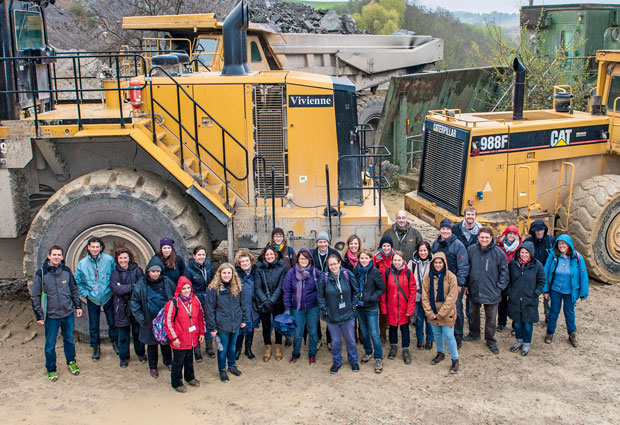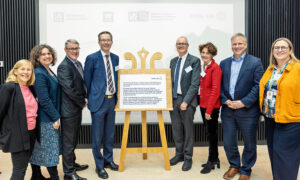
Bioinformatics with a bang
Unexpected adventures at EMBL LearningLAB focused on biodiversity

“You might want to cover your ears,” smiles Philipp Gebhardt, head of EMBL’s European Learning Laboratory for the Life Sciences (ELLS), looking out over the meadows that roll up to the rocky cliff face of Nußloch Quarry in the distance. Two dozen schoolteachers and teacher trainers are stood behind a safety barrier, here as part of a LearningLAB focussed on bringing bioinformatics into the classroom. It is an unlikely location for a lesson in computer science, and the group has carefully collected plant samples for analysis in the teaching labs at EMBL’s Heidelberg site 12 kilometers away. But before that there is a surprise in store.
Suddenly, a loud explosion rings out across the quarry, sending tonnes of sediment tumbling to the foot of the mine. It’s an intimidating sight: plumes of dust are thrown into the air and a brigade of diggers wait impatiently to snap up the haul, which will be used by building materials company HeidelbergCement. But while quarries are destructive by reputation, when carefully managed and restored they provide important habitats for a wide range of flora and fauna – including rare birds, amphibians and plants such as wild orchids. Participants are here to learn how modern molecular methods can be used to study this rich biodiversity.
Real insights
“Our goal is to provide training for accessible, hands-on lessons that convey the excitement of real science,” says Gebhardt. In the training lab, teachers adorn lab coats and start getting to grips with an array of pipettes, solutions, centrifuges, water baths and rubber gloves. Under the guidance of EMBL scientists and ELLS educators, they extract DNA from samples, amplify the barcode regions using the polymerase chain reaction and prepare them for sequencing.
“It’s challenging, but there has been lots of support from experts,” says Niti Dhingra, a secondary school biology teacher from Berlin, pleased with her progression during the three-day LearningLAB. When the sequences are returned the following day, the group analyses and compares the data from their samples, making use of EMBL-EBI’s European Nucleotide Archive, to evaluate the diversity of plants collected. “Each course is supported by specialised education resources developed by the ELLS team,” explains Eva Haas, an ELLS education officer. “We want to inspire teachers by providing a direct connection between classroom exercises and science in practice.”
Modernising methods
The course is packed out with seminars, lab tours and social activities, and is part of a wider programme that delivers several courses each year, with the ultimate goal of modernising science teaching. “We can immediately pass on what we have learnt,” says Marinke van der Velde of the Institute for Teacher Training in Rotterdam as the LearningLAB reaches its conclusion, the bioinformatics analysis of the DNA barcodes underscoring the high diversity of plant life in the quarry environment. “It’s one of the best courses I have been on,” she adds.


